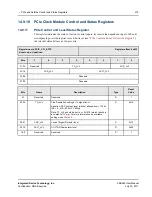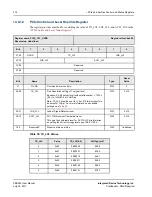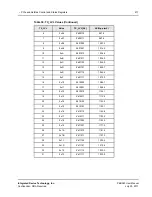
15. Electrical Characteristics > AC Timing Specifications
225
PEB383 User Manual
July 25, 2011
Integrated Device Technology, Inc.
Confidential - NDA Required
Note that all Figure and Section references are to the
PCI Express Base Specification (Revision 1.1)
.
1. No test load is necessarily associated with this value.
2. Specified at the measurement point into a timing and voltage compliance test load as shown in Figure 4-25 and measured
using the clock recovery function in Section 4.3.3.2. (also see the transmitter compliance eye diagram in Figure 4-24).
3. A T
TX-EYE
= 0.75 UI provides for a total sum of deterministic and random jitter of T
TX-JITTER-MAX
= 0.25 UI for the Transmitter
using clock recovery function specified in Section 4.3.3.2. The T
TX-EYE-MEDIAN-to-MAX-JITTER
specification ensures a jitter
distribution in which the median and the maximum deviation from the median is less than half the total TX jitter budget using
the clock recovery function specified in section 4.3.3.2. It should be noted that the median is not the same as the mean. The
jitter median describes the point in time where the number of jitter points on either side is approximately equal as opposed the
averaged time value. This parameter is to be met at the target bit error rate. The T
TX_EYE_MEDIAN-to-MAX-JITTER
is to be met
using the compliance pattern at a sample size of 1,000,000 UI.
4. The Transmitter input impedance shall result in a differential return loss greater than or equal to 10 dB with a differential test
input signal no less than 200mV (peak value, 400 mV differential peak to peak) swing around ground applied to D+ and D-
lines and a common mode return loss greater than or equal to 6 dB over a frequency range of 50 MHz to 1.25 GHz. This input
impedance requirement applies to all valid input levels. the reference impedance for return loss measurements is 50 Ohms to
ground for both D+ and D- line (that is, as measured by a vector Network Analyzer with 50 Ohm probes - see Figure 4-25).
Note that the series capacitors C
TX
is optional for the return loss measurement.
5. Measured between 20-80% at the Transmitter package pins into a test load as shown in Figure 4-25 for both V
TX-D+
and
V
TX-D-
.
6. Z
TX-DIFF-DC
is the small signal resistance of the transmitter measured at a DC operating point that is equivalent to that
established by connecting a 100-Ohm resistor from D+ and D- while the TX is driving a static logic one or logic zero.
Equivalently, this parameter can be derived by measuring the RMS voltage of the TX while transmitting a test pattern into two
different differential terminations that are near 100 Ohms. Small signal resistance is measured by forcing a small change in
differential voltage and dividing this by the corresponding change in current.
L
TX-SKEW
Lane-to-Lane Output
Skew
-2.8
-
500 + 2 UI
ps
Static skew between any two
Transmitter Lanes within a single
Link
C
TX
AC Coupling Capacitor
75
-
200
nF
All Transmitters must be AC coupled.
The AC coupling is required either
within the media or within the
transmitting component itself.
Tcrosslink
Crosslink Random
Timeout
0
-
1
ms
This random timeout helps resolve
conflicts in crosslink configuration by
eventually resulting in only one
Downstream and one Upstream
Port. See Section 4.2.6.3 of the
PCI
Express Base Specification
(Revision 1.1)
.
Table 47: PCIe Differential Transmitter Output Specification
(Continued)
Symbol
Parameter
Min.
Nom.
Max.
Units
Comments
















































